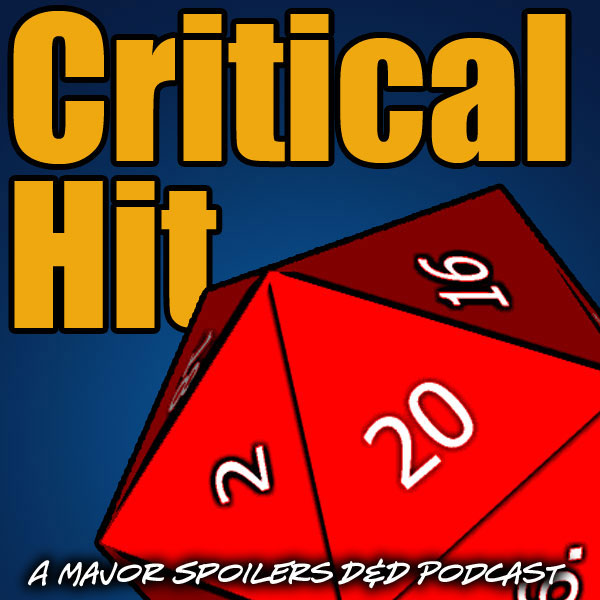Welcome to a special series in which I discuss the house rules I use for Critical Hit. Today we’ll cover one of the simplest, yet most controversial rule I’ve implemented. It deals with blasts and bursts.
PROLOGUE: WHY MAKE CHANGES AT ALL?
Unlike most of my other house rules this one doesn’t try to fix a problem, but instead tries to create a play style. Yes, I understand that it can be very frustrating to miss every enemy with a bad roll, but I also know that it is amazing when you nail every enemy with a good roll. Simply put, this rules change places higher stakes on area attacks, which makes for a more exciting game.
RODRIGO’S HOUSE RULES FOR BLASTS AND BURSTS
These rules concern attacks that read “Target: Each Creature (or enemy) in burst (or blast)”
Rather than making an individual attack roll for each creature in the area of the attack the player makes a single roll and applies it to each creature in the burst.
If the character has an ability that allows for a reroll (like Elven Accuracy), adds a retroactive bonus to the attack roll (like Wand of Accuracy), or adds an additional effect to the attack (Like the Flaming property in weapons) that character’s player selects one target in the burst. The reroll, attack bonus or effect applies only to that enemy.
Likewise if a target of a blast or a burst has an ability that causes the attacker to reroll (like Halfling Luck) or changes any aspect of the power, the reroll and/or other effects apply only to the character using the ability.
Critical Hit House Rules Archive




8 Comments
The problem I have with this house rule is makes Orem less useful in a fight. He has opted out of using his control powers because he never hits and while most of his powers are half damage on a miss, the control portions of the powers are usually on a hit. I also do not think that this house rule speeds up anything. Since it seems like you guys usually need greater than a 10 on a d20 to hit, this means that you will miss most often with spells that are supposed to hit half the targets. Thus less monsters are damaged, less monster actions are removed from the turn and that means the fights are longer.
But Rodrigo is the GM and what he says goes. So my advice to the players is to make sure your To-Hit bonuses are the highest you can make it. Get Expertise feats, seek Combat Advantage, do everything you can to maintain your weapons and implements at the highest possible Enhancement bonus. I think you guys feel like doing such a thing is power gaming but it will make the episodes when you have fights much more entertaining. Fights where you guys miss all the time are excruciatingly boring and long.
@zaranblack I disagree on reduced effectiveness. They’ve simply condensed the chance on each individual hit to a single roll, but I think the statistics on each hit aren’t effected.
It certainly doesn’t speed things up because half the participants need to relearn basic rules like the difference between burst and blast and how charge works. It eats any time saved in other places.
No offense guys but if I can said to have a pet peeve on the show it’s that you’ve been playing for years and forget the basics. Drives me crazy.
Anyway love the show otherwise.
Thanks Rodrigo for the insight.
If the encounters were designed around the fact that a roll of 10 or greater, then it would be true that statistically speaking a single roll should be not much different than many. But more times than not it seems like they are needing 11s or 12s or even higher to hit. And with the Non-Mathews that makes all the difference in the world. The game is designed around the idea that targets are supposed to be hit 55% of the time (rolling 10-20 on a d20). So an area effect power should hit about half the targets every time it’s used. With this house rule, coupled with the higher than normal rolls needed, it means monsters are hit less than they are supposed to. And that means the fights are longer. I think the multiple rolls can be remedied easily just by rolling a die for each monster all at once.
I do agree that it would be nice if everyone in the group would learn the basic rules but I think half the time they are asking questions for the benefit of the listeners.
I have adapted Rodrigos rules. But it is true that it makes the controllers less reliable.
Its great for strikers! Not soo much for controllers since you want reliability for them.
I can’t wait to see the stealth rules.
I am playing a Dwarf Rogue right now and trying to hide and steal is ver frustrating
We started using house rules similar or identical to these before we had read the rules for it in the DMG, and honestly, once we found out, we thought our version was better. It’s more streamlined and when we’re 6 players and a DM, combat tends to take a while. The balancing wasn’t so much an issue since our strikers tended to pulverize anything dangerous in short order, and my extremely tanky Goliath Warden could soak up most anything they could throw at us.
Love seeing house rules. I’ve implemented this particular one in my game. I find it helpful in speeding up combat, which is great since I prefer my game more RP based.
I have to say this is the only Rodrigrule that I don’t like. Imo the disappointment of completely missing a big spell far outweighs the excitement of hitting everything with it. In addition it trivializes minions.
I was using the rule for a while and found that my friend’s drgaonborn elementalist could clear an entire pack of minions with not much more than a mean glance. I had to start rolling for every minions to make fights less of a cakewalk, and eventually just switched over to the normal rules for consistency. We employ the method of rolling all of the attacks at once (like zaranblack suggested) and just assign dice based on the pattern they fall in (e.g. the top-leftmost die is assigned to the top-leftmost creature). It’s not quite as fast as a single roll, but it streamlines keeping track of which die was for which creature a bit.
I realize this is a personal preference though. Rodrigo is a big boy and can do what he wants. :p